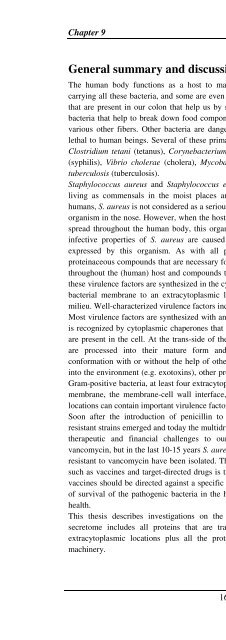The Staphylococcus aureus secretome - TI Pharma
The Staphylococcus aureus secretome - TI Pharma
The Staphylococcus aureus secretome - TI Pharma
Create successful ePaper yourself
Turn your PDF publications into a flip-book with our unique Google optimized e-Paper software.
Chapter 9<br />
General summary and discussion<br />
<strong>The</strong> human body functions as a host to many bacteria. Normally, we have no problem<br />
carrying all these bacteria, and some are even beneficial to us. One can think of the bacteria<br />
that are present in our colon that help us by synthesizing vitamins (Vitamine K, biotin), or<br />
bacteria that help to break down food components that we cannot digest, such as starch and<br />
various other fibers. Other bacteria are dangerous pathogens, causing diseases that can be<br />
lethal to human beings. Several of these primary pathogens cause well known diseases, like<br />
Clostridium tetani (tetanus), Corynebacterium diphtheria (diphtheria), Treponema pallidum<br />
(syphilis), Vibrio cholerae (cholera), Mycobacterium leprae (leprosy) and Mycobacterium<br />
tuberculosis (tuberculosis).<br />
<strong>Staphylococcus</strong> <strong>aureus</strong> and <strong>Staphylococcus</strong> epidermdis are two of those bacteria that are<br />
living as commensals in the moist places and the skin of the human body. For healthy<br />
humans, S. <strong>aureus</strong> is not considered as a serious threat and ~20% of the population carries this<br />
organism in the nose. However, when the host defenses are breached and S. <strong>aureus</strong> is able to<br />
spread throughout the human body, this organism can turn into a dangerous pathogen. <strong>The</strong><br />
infective properties of S. <strong>aureus</strong> are caused by the arsenal of virulence factors that are<br />
expressed by this organism. As with all pathogens, these virulence factors are often<br />
proteinaceous compounds that are necessary for the bacterium to invade, colonize and spread<br />
throughout the (human) host and compounds that contribute to the symptoms of disease. All<br />
these virulence factors are synthesized in the cytoplasm of the cell and translocated across the<br />
bacterial membrane to an extracytoplasmic location, such as the cell surface or the host<br />
milieu. Well-characterized virulence factors include the many exotoxins of S. <strong>aureus</strong>.<br />
Most virulence factors are synthesized with an N-terminal signal peptide. This signal peptide<br />
is recognized by cytoplasmic chaperones that lead the protein to translocation pathways that<br />
are present in the cell. At the trans-side of the membrane, the translocated virulence factors<br />
are processed into their mature form and folded into the correct three-dimensional<br />
conformation with or without the help of other proteins. While several proteins are released<br />
into the environment (e.g. exotoxins), other proteins are retained at the surface of the cell. In<br />
Gram-positive bacteria, at least four extracytoplasmic cellular locations are distinguished: the<br />
membrane, the membrane-cell wall interface, the cell wall and the cell surface. All these<br />
locations can contain important virulence factors.<br />
Soon after the introduction of penicillin to eradicate the threat of S. <strong>aureus</strong> infections,<br />
resistant strains emerged and today the multidrug resistant S. <strong>aureus</strong> strains are imposing both<br />
therapeutic and financial challenges to our health care. <strong>The</strong> last resort antibiotic is<br />
vancomycin, but in the last 10-15 years S. <strong>aureus</strong> strains that are less susceptible or even fully<br />
resistant to vancomycin have been isolated. <strong>The</strong> need to search for alternatives to antibiotics<br />
such as vaccines and target-directed drugs is therefore increasing. <strong>The</strong>se alternative drugs or<br />
vaccines should be directed against a specific protein or process which decreases the chance<br />
of survival of the pathogenic bacteria in the human host without interfering with the host’s<br />
health.<br />
This thesis describes investigations on the <strong>secretome</strong> of S. <strong>aureus</strong>. By definition, the<br />
<strong>secretome</strong> includes all proteins that are translocated across the bacterial membrane to<br />
extracytoplasmic locations plus all the proteins that make up the protein translocation<br />
machinery.<br />
164













